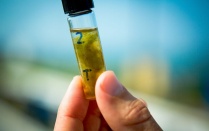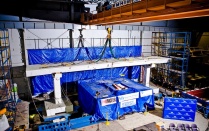New study will quantify agricultural emissions and their impact

The new method can provide information on agricultural pollution emissions almost as quickly as the satellite itself.
By Peter Murphy
Published May 13, 2024
Kang Sun, assistant professor in environmental engineering, is playing a crucial role in a NASA-funded project to quantify the impact that different nitrogen emissions have on productivity and air quality.
The study, led by Kaiyu Guan, associate professor and director of the University of Illinois Urbana-Champaign’s Agroecosystem Sustainability Center, will examine two nitrogen fluxes: ammonia and nitric oxide/nitrogen dioxide (NOx).
According to Sun, the team at UB will use an observation-based approach that he developed, which is detailed in a paper published in the Geophysical Research Letters and expanded upon in a paper published in the Atmospheric Chemistry and Physics journal. The method uses satellite images and wind data to determine where the nitrogen fluxes come from. The method also maps pollution levels at high resolution and how they change over time.
“We expect higher column amount of the fluxes directly downwind of emission sources,” Sun says. “Since this approach does not rely on any resource intensive computer models, it can inform pollution emission quickly, almost as timely as the satellite data product itself.”

Kang Sun
According to Sun, this project could provide valuable insights on these fluxes that have not been as available as similar data on other emissions.
“What makes this project challenging and exciting is that we will look at relatively weak and diffusive emission from agricultural activities. Compared with urban, fossil-fuel-based emission sources, the agricultural sources are poorly quantified and regulated and may have disproportional impact on air quality and climate change,” Sun says.
Other collaborators include Mark Zondlo, professor of civil and environmental engineering at Princeton University; Steven Hall, assistant professor in agricultural and life sciences at the University of Wisconsin-Madison; Wendy Yang, professor of plant biology and associate director of the Agroecosystem Sustainability Center; and Bin Peng, assistant professor of water and agriculture at the University of Illinois Urbana-Champaign.
The interdisciplinary team of researchers aim to develop guidance for farmers on nitrogen fertilizer and ways to ease nitrogen emissions from agricultural processes, and improve air quality on farms and other agricultural sites.









